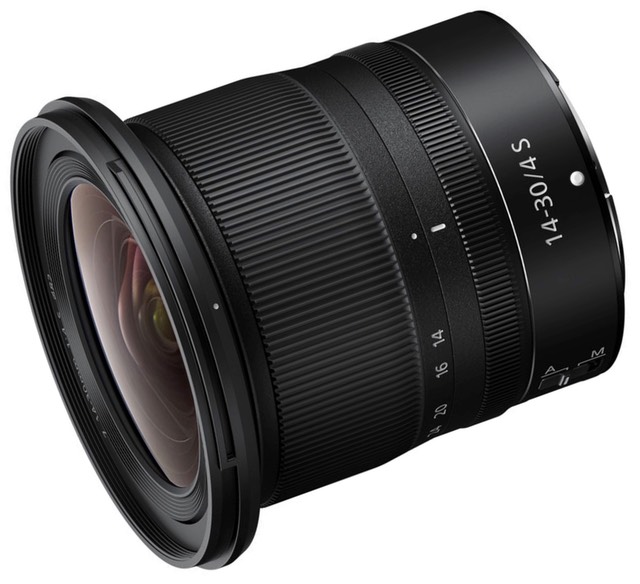
What is It?
The 14-30mm f/4 S is the first wide-angle zoom for the Z series bodies (a 14-24mm f/2.8 S will follow in 2020). Unlike most wide-angle zooms, the Nikkor 14-30mm f/4 S is smallish and doesn't have a bulbous front element that precludes filters. So it's immediately intriguing to the Nikon Z6 and Z7 owner looking for wide angle options.
At 17.1 ounces (485g) and 3.5" (89mm) in length, the 14-30mm f/4 is very close in size and weight to the 24-70mm f4 S kit lens, which is surprising. Short of a couple of the DX wide angle zooms, I've not seen another wide angle zoom that seems "small" on the body it fits on.
Again there's that "S" in the lens designation. Nikon's been saying that stands for "superior," or a high end lens specification (as opposed to a lesser consumer specification like the 18-35mm f/3.5-4.5G has). We'll get to whether the lens performs up to that "S" marketing claim in the performance section towards the end of this review, but it's interesting that Nikon is making a mirrorless full frame zoom they claim as high quality that's basically as small as the most consumer option the company made for DSLRs.
Overall the lens is 14 elements in 12 groups. The element positioning, shape, and size looks a bit different in this S lens than we typically see, though. There are four aspherical elements, plus four ED elements. Compared to that 18-35mm in the F-mount, the S lens seems to have slightly bigger inner elements (the ones that move for focus) and a larger and simpler rear element design (which is also very close to the image sensor).
Nano coating is on at least one element (along with the usual Super Integrated Coatings), and the front element is fluorine coated to reject water and dust. The lens has a 82mm filter thread and a fairly flat front element, which was a surprise to many. You can use filters on this lens, but at 14mm you're probably going to want thin filters so as not to vignette.
Nikon claims "extensively sealed against dust and moisture," and this seems to be accurate. The supplied HB-86 lens hood is a bayonet type, and not very deep, so it doesn't do a lot of shading of the front element. Inside we have 7 rounded aperture blades. The lens stops down to f/22.
There's no distance scale (and obviously no DOF markings). Curiously, the lens has a very close focus point of 11" (0.28m), though given the wide angle nature, that doesn't make the lens very "macro" (1:6.3 maximum magnification range).
As with all Z lenses, Nikon has brought forward both the E-type design (electronically controlled aperture) and AF-P focus design (stepper motor that's fast and able to move in small increments accurately). All focus is done internally, but when you zoom the lens extends significantly forward (as much as an inch; at full extension—14mm—the lens is about 4.5" from mount to the filter ring).
I should point out that this is one of those "rotate lens to use" designs. For travel and storage the lens contracts to its base ~3.5" length. Rotating the zoom ring to 14mm extends the lens into shooting position and moves the front forward an inch.
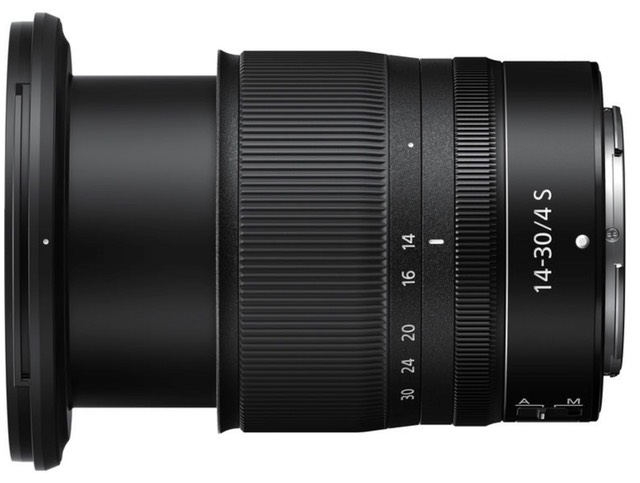
The 14-30mm f/4 S has one switch (A/M) and two rings. The zoom ring is the frontmost ring and marked at 14mm, 16mm, 20mm, 24mm, and 30mm positions and rotates in less than a quarter turn from widest to wide (again, there's a "retracted point, which requires moving the lens another 1/8 of a turn from 14mm).
The focus ring is narrow, unmarked, and closest to the camera. As with almost all mirrorless camera lenses, the focus ring is "fly-by-wire" and isn't mechanically linked to lens element movement. The focus ring can be repurposed on Nikon Z bodies to other functions (aperture, exposure compensation, etc.).
The 14-30mm f/4 S is made in Thailand and retails for US$1300.
Source of the reviewed lens: purchased
How's it Handle?
One issue I contended with over and over: the lens hood is easy to dislodge from the proper position on my sample. Given how tight the edges of that hood are to the coverage area, you'll end up with two opposite corners completely shaded when this happens. The lens hood on my 24-70mm f/4, which also doesn't have the lock button, is much more secure on that lens than the one that came with my 14-30mm.
When you're working fast at events (particularly in low light), you may not notice the askew lens hood right away. Nikon is literally saving pennies not putting the retainer on these hoods and requiring us to press a release button to unlock them.
Other than that, virtually all the comments I've made about handling on the 24-70mm f/4 S would apply here. Which is to say:
I don't particularly like the "rotate to use" aspect of the lens, though I appreciate the bit of extra space it saves when traveling. Still, there's the potential for missing a shot if you don't immediately put the lens at the 14mm position after you take it out of your bag.
Both rings are smooth on my sample, and the build quality feels solid, a bit above that of the f/1.8G primes Nikon has made for the F-mount. The lens balances very nicely on the smallish Z bodies; it's hardly noticeable.
Nikon tries to market the lens as suitable for video. I'm not sure I agree with that, unless you're using the lens solely in autofocus mode. You're certainly not going to manually focus by wire in your video given the lack of good hysteresis in the fly-by-wire mechanism. Nikon seems to think that videographers will use the focus ring for aperture control in video, but it's difficult to be precise, in my experience.
How's it Perform?
Sharpness: Based upon Nikon's published MTF charts, I was expecting better. Those charts suggest at 14mm that we'd have very high sagittal sharpness across the frame, falling off with perhaps a bit of coma or spherical aberration out past the DX frame mark.
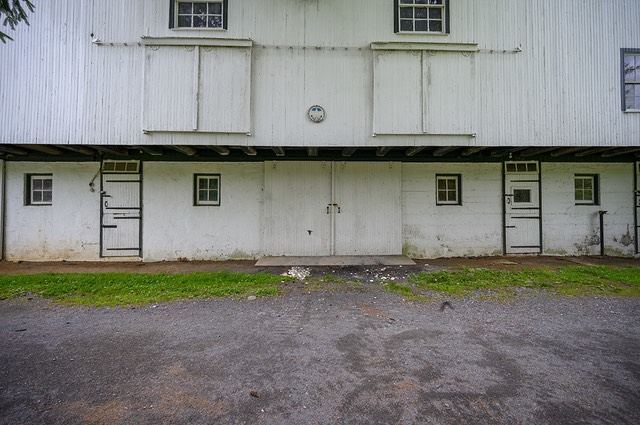
14mm is wide, really wide. Even on a Z6 there's plenty of detail in the frame.
Those Nikon published charts also suggest the center is excellent wide open at 14mm, with high contrast, and that's very true on my sample. The center of frame is probably best at f/5.6, but f/4 is close. Both are what I'd call excellent. 30mm, however, has a completely different pattern: There's strong improvement from f/4 to f/5.6 in the center. Very strong improvement. I'd consider f/4 only very good at 30mm in the center, and the center only reaches excellence at f/5.6. This lens seems to perform best at 16-20mm, slightly less well at 14mm and 20-30mm.
Corners are not quite as good as I'd hoped (with a caveat). They're not at all terrible wide open, but they're distinctly different than the center at 14mm. Indeed, the extreme corners never really get close enough to the center performance, and that's true of both corrected and uncorrected lens distortions. So at 14mm and f/4, if I say the center is excellent, the corners would be fair to good. And at 14mm and f/8 if the center is very good then the corners are just good. Things improve at 16-20mm, where I'd say the corners are one "notch" higher (e.g. good becomes very good, very good becomes excellent). Again, once you get past 20mm, things tend to break down in my sample. The extreme corners never get out of the optical doldrums until f/11, by which time diffraction is stealing acuity on the Z7.
Side to side—left edge of the frame to right edge at the center vertically—things are much better, and that's probably the redeeming factor for this lens, as that's generally where people want sharpness. So it seems clear to me that the biggest issue of falloff of sharpness is happening near the outside of the image circle, and that image circle is very tight to the extreme corners at some focal lengths (see vignetting).
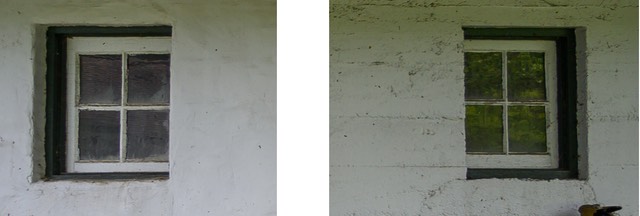
We're at f/4 here, and the sensor is as close to parallel to the barn as I could get it. What we're looking at below is the left side window and right side window on the vertical center line blown up. Both are sharp with lots of detail. That's what I mean when I say that the lens redeems itself in the side-to-side tests. It's really only the extreme corners where I start to have issues with the lens.
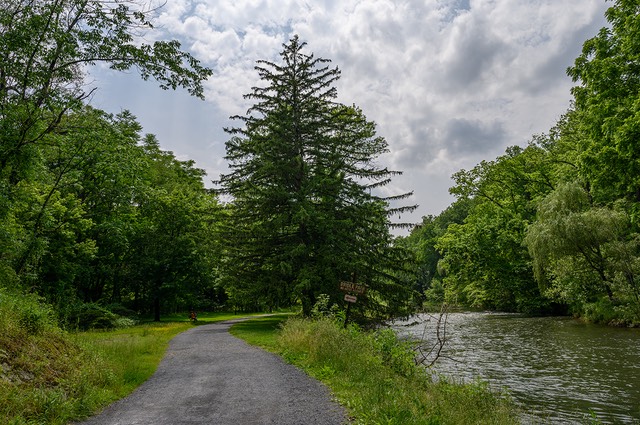
This lens, unlike the other S lenses I've tested, also seems to be a little different in character at different focus distances. Infinity is actually probably its worst distance in the extreme corners, but minimum focus distance also shows something similar. It's in the range most people would be using the lens that it does best.
These results aren't quite what I was expecting, though for a wide angle zoom they're not at all bad. Many would say they're quite good. Where I'd tend to be using the lens in landscapes or cityscapes or interiors (14mm and f/8) it actually does a very credible job, and without the field curvature and focus shift issues we often see in the wide zooms.
Note: a couple of people I trust have gotten 14-30mm f/4 S lenses that clearly have a lens element alignment (appears to be tilting) issue, as one or two corners show differing results, and the sharpness results appear to "wobble" a bit with zoom and focus. I'm basing my judgement on the sample I bought.
Coma is actually well handled with the lens at 14mm, which is where I'd most want that to be true (think star fields). This seems to be a trait with all the Nikkor S-line lenses.
Chromatic aberration: Little longitudinal or lateral chromatic aberration. But it seems clear to me that the lens corrections being applied to raw files (e.g. via the Adobe converters) are also sometimes wrong. What happens is that you go from little CA (uncorrected raw) to very visible CA at the edges (corrected raw) in some files. Hmm. How is that "lens correction"?
Linear distortion: Without the lens correction profiles, this lens has considerable barrel distortion at 14mm, well above the 3% threshold at which you almost certainly have to correct it. Minimal distortion occurs somewhere around 20mm, after which things turn to modest pincushion distortion. It's really in the 14-16mm range that distortion is enough of an issue that correcting is absolutely necessary for most photographic subjects and starts to impede pixel integrity in the corners.
Vignetting: Surprisingly high, though I suppose that the small size of the lens is a giveaway that there were tradeoffs involved optically. Wide open we're at three stops in the extreme corners with no correction. Things improve considerably with the lens corrections applied. That's partly because the absolute corners disappear when linear distortion is corrected. The good news is that vignetting accelerates rapidly right near the corners, meaning that most of the image area stays fairly free from darkening. Still, I regard the vignetting as high for this lens, at least for 14mm (the vignetting improves as you zoom in).
Note that you have to be careful about what filters you put on this lens, or else you'll get even more vignetting and corner issues. Some "regular" filters seem to clearly show in visibility at 14mm. You need very thin filters at 14mm.
Flare: Actually well controlled for a wide angle lens, though as Jim Kasson noted, watch out for bounce back flare off the mechanical shutter. Nor does this Nikkor have the annoying circular flare that the Sony 12-24mm can sometimes produce. Overall, the 14-30mm f/4 is one of the better performing wide angle zooms I've seen for flare.
Bokeh: Bright edges with a small amount of onion skinning visible internally. Not a lot of color to the edging, though. In the extreme corners there's little cutting off of blur circles due to mount or other issues. However, the aperture blades in my sample have a slight non-symmetrical aspect to them, and that can be seen in out-of-focus highlights.
Final Words
The 14-30mm f/4 S is probably the least deserving of the S designation so far, at least in my opinion. If the S was supposed to indicate Superior, I'd tend to say this wide angle zoom falls just a little short of that.
That doesn't mean it's a bad lens, but that it definitely has some clear plus and minus points you need to be aware of.
Let's start with a plus: landscape photographers and those that spend most of their time at the wide end at smaller apertures are probably going to like this lens: the center is excellent and the corrected corners can get to very good at many focal length/aperture combos. You're going to want to leave those lens corrections on, though, as linear distortion and vignetting are very high at 14-16mm without them. That the lens takes 82mm filters makes it a friendly lens to the landscape shooter, too, though you need very thin filters not to vignette.
Coupled with the small size and weight coupled with good performance overall, I can see the landscape, cityscape, and travel folk really liking this lens.
Yet...there's an inherent tradeoff going on here that's a bit tough to reconcile. Because the lens has so much vignetting and linear distortion at 14mm, the landscape shooter is going to want to be correcting those, and the current corrections can introduce some chromatic aberration, smear the corner sharpness a bit, and can potentially raise corner noise issues in some situations. So be aware of that.
On my sample the drop-off in sharpness by 30mm is noticeable, and it's far worse in the corners wide open. Event shooters might not like that. The corners also never really reach the levels I'd really like them to at any focal length and aperture setting at 30mm. The vignetting, as noted, is high; even corrected it remains visible at 14-16mm.
The lens extends to its maximum length at 14mm, where it doesn't look quite as svelte as it does out of the box. But it's still reasonably small overall, particularly when compared to the 16-35mm f/4 in the F-mount. And of course, you've got that need to twist the lens into shooting position after you mount it a lot of us don't like.
In many ways the 14-30mm f/4 S reminds me of the 16-35mm f/4G in the F-mount. They share plenty of the same issues on the optical side, mostly due to the high level of linear distortion. Indeed, I wouldn't be surprised to find that Nikon's design goals for the two lenses were similar, or that the same optical engineers worked on them.
I originally recommended the 16-35mm f/4G, but the more I used it the more I decided that it didn't deserve that much praise. The 16-35mm f/4 is a useful lens for many, but not one that I could tell everyone to jump on board with. Since I'm getting the exact same feeling with the 14-30mm f/4 S, I'm not going to give it a Recommended rating. That said, I like it, and I'm using it with good results. Maybe I'm just being a bit harsh on the corners because Nikon says it is "superior."
The recommendation I will give the 14-30mm f/4 is this: it's one of the three-lens set that those traveling with Z's looking for versatility probably should adopt (14-30mm f/4, 24-70mm f/4, and 70-300mm AF-P on the FTZ adapter).
Recommended (conditional) (2020, 2021, 2022)
Support this site by purchasing from the following advertiser:
